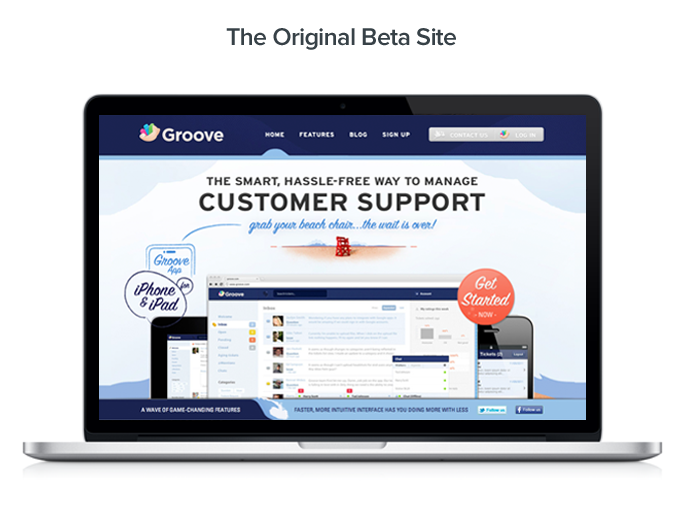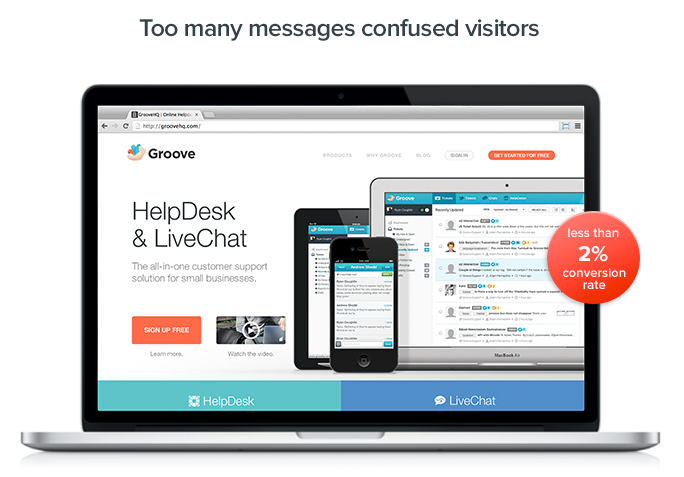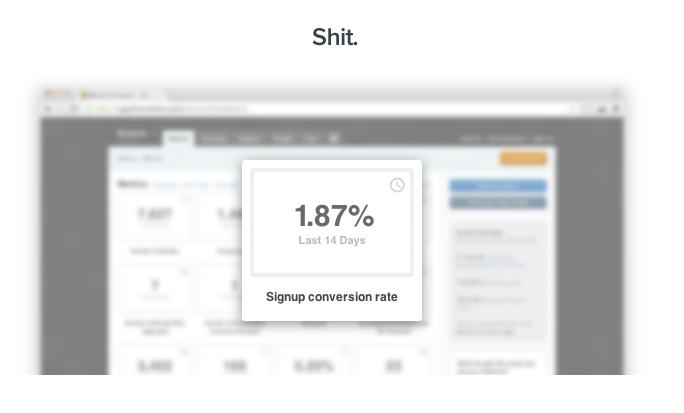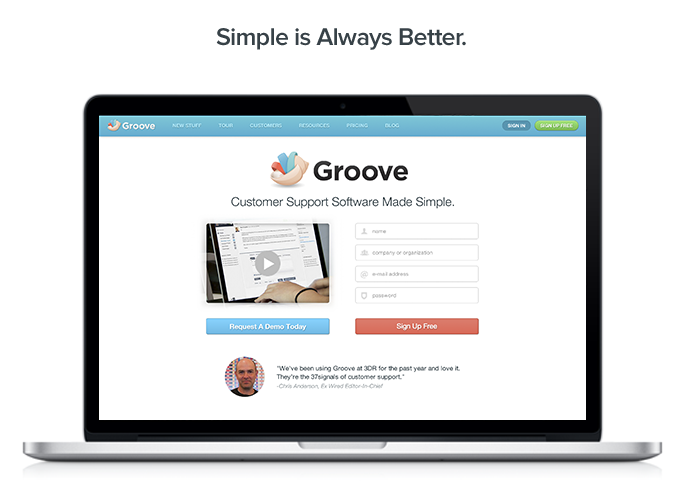3 mistakes that nearly killed a cool startup

If you work in a startup, you know how fragile a business is. Jumps in income, disruption of investments and a lot of things can destroy a project at any time.
In this article, we analyze the experience of the Groove online service — 3 situations where, according to the developers, they “burned and fell into the abyss”.
Groove - SaaS-solution for organizing the work of customer support (Helpdesk); one of the most notable startups of "burzhunet".
')
The temptation to sell a business
Groove's founder Alex Turnbull recalls: “We did not have time to launch the beta version, as I received two offers to sell the project at once. This money would more than make up for all our work on the service within 6 months. ”

“It's a damn strong temptation to cut the dough quickly. Instead of working on a project, I was thinking about how to fill the price for buyers. I reduced the cost of product development to a minimum and negotiated for negotiations in the hope that we will get rich soon.
After the 10th meeting, I was suddenly "covered": why did we make Groove? For a stable and secure life, the ability to do everything that we love. Regardless where my team works - in the office or remotely. And now take and start all over again? Developing and selling projects every three years is not the best way to realize dreams of stability and well-being.
When I woke up, I realized that I had “killed” almost a year to meet with potential buyers at the expense of the product, because we had to constantly distract the team from developing + we refused to participate in the cool conference of IT start-ups.
In this case, the problem is not in the proposals for the sale of the project per se. A lot of founders are asleep and they see as if someone has “rolled up” to them with good money. The problem is that when you are tied up in choosing a co-founder or even what software to put in for bookkeeping, you lose focus, the main goal to which your startup should move.
Moreover, when the founder “hovers in the clouds” for several months, the project will quickly “bend”. You need to clearly know why you started this game and never forget about it. ”
Create a monster
So Alex Turnbull calls the product Groove in its early stages. He says: “We had a vislist of functions that need to be implemented. And somehow imperceptibly they turned from wishes to duty. Debris of excess functionality almost buried the original goal - to make a simple, elegant solution. We added features for features, postponing product launches because of this. ”
This is how web design looks in comparison: a wishlist model and a focused model.

Unfortunately, in reality this is not the case. We understood this when we analyzed the reasons why users of the beta version “fall off” so quickly. Because our product instead of a monolithic building looked like a pile of debris, in which it is very difficult to choose the right things. Plus, the process of entering the user is too long - 6 steps before you can start working ":

“The user must be incredibly“ charged ”to go this way. Of course, there was a wild amount of mistakes. And the barely noticeable tab “Need Help?” In the lower right corner. It is not surprising that the product resembled a monster, because we tried to bring all these options to each user.
As a result, we had a bunch of unique functionality, right up to the gamification of the application and ... not a single payment.
Now our landing page has one goal - to get as many subscribers as possible. And in terms of product, to become the best in the market for a specific audience (Groove relies on small business). Trying to be "everything for everyone" means for no one. "
One unforgivable mistake costing $ 50,000 that startups should not allow
Instead of showing how Groove solves the needs (or "pain") of the target audience, the developers wrote down the project history on the main page of the site.
Original version:

As a result, instead of converting to subscribers, the site essentially entertained visitors.
Alex Turnbull was worried at this moment that the short Groove landing page compared to its competitors (Desk.com, Zendesk and UserVoice) looks too “Spartan”. This is where everything went wrong.
First, Groove conducted a large-scale study of the market, which amounted to a 42-page “Talmud”. According to Alex, “we set out to surpass everyone. At least, to do no worse - a long landing page with carousels and dynamic images. ”
A couple of landing page sketches during design:

Creating a "perfect" design so fascinated developers that they forgot about finances. The half-dead project did not generate revenue, however, "we did block by block, page by page and did not test on any of the users."
Working layouts:

But the result of the 5-month process:

2 weeks after the launch, the analyst shocked the Groove team. A nice site "like people" gave ... less than 2% of conversions in registration. According to Alex, he felt a feeling when "you realize that you made an unforgivable mistake and something breaks inside you."
Sad result:

Almost none of the visitors even scrolled past the first screen. But even more was in the wrong positioning. Groove presented themselves as a “company with a set of tools for customer support”, and not just a solution for organizing the work of customer support. Therefore, the visitors "ran their eyes," and no one was sure what exactly they were offered.
When it became clear that the conversion would not go beyond 2%, Alex decided to “kill” this site at the cost of $ 50,000 and 5 months of work. “By swallowing our own pride, we made a new design in 3 days. No live chat, no supporting apps. Focus only on benefits as helpdesk platforms. ”
The simpler the better:

As a result, the conversion has tripled (!). The founder of Groove advises: “Leave a lot of research, anyway, you will not develop the perfect design. Just make and run an acceptable option. Next - test, measure the conversion, “finish” some things, test again.
Our main mistake is overconfidence. In the end, users do not care for the company's grandiose plans. They want one thing: to solve their problems. Therefore, formulate an offer so that it is extremely clear what value you are giving. ”
How it all ended
Alex Turnbull has become a fan of learning user experience through feedback. He personally spent more than 100 hours in communication with Groove customers (for details, see the Customer Development article for start-ups: a conversation with 500 customers ).
This made it clear that many of the functions of the service are not in demand and made it possible to focus on things that are really important to users. And, then, on what brings income. Recently, Groove overcame the $ 100,000 monthly revenue threshold.
Commentary founder Alexander Yagla.ru Alimov
We also had the temptation to overload the product with redundant functionality, it's so cool: to make a universal solution so that users do not work with 10 applications, but do everything in one place. In time pushed this idea)
Until now, we get the questions "Why do not you implement the functionality for the automation of contextual advertising?" Because we specialize in one feature - dynamic content, and try to make it the best in the market. The “all inclusive” approach (for example, generating campaigns, managing bids, etc. + setting up dynamic content) will inevitably lead to the “sagging” of some stage. Attempting to be “everything for everyone” means to no one.
Share your comments in the comments and what you think about it.
Source: https://habr.com/ru/post/296290/
All Articles